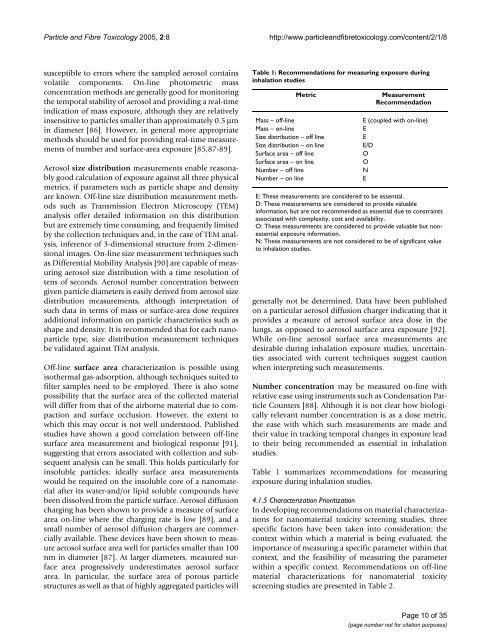Particle and Fibre Toxicology - Nanowerk
Particle and Fibre Toxicology - Nanowerk
Particle and Fibre Toxicology - Nanowerk
Create successful ePaper yourself
Turn your PDF publications into a flip-book with our unique Google optimized e-Paper software.
<strong>Particle</strong> <strong>and</strong> <strong>Fibre</strong> <strong>Toxicology</strong> 2005, 2:8<br />
http://www.particle<strong>and</strong>fibretoxicology.com/content/2/1/8<br />
susceptible to errors where the sampled aerosol contains<br />
volatile components. On-line photometric mass<br />
concentration methods are generally good for monitoring<br />
the temporal stability of aerosol <strong>and</strong> providing a real-time<br />
indication of mass exposure, although they are relatively<br />
insensitive to particles smaller than approximately 0.5 µm<br />
in diameter [86]. However, in general more appropriate<br />
methods should be used for providing real-time measurements<br />
of number <strong>and</strong> surface-area exposure [85,87-89].<br />
Aerosol size distribution measurements enable reasonably<br />
good calculation of exposure against all three physical<br />
metrics, if parameters such as particle shape <strong>and</strong> density<br />
are known. Off-line size distribution measurement methods<br />
such as Transmission Electron Microscopy (TEM)<br />
analysis offer detailed information on this distribution<br />
but are extremely time consuming, <strong>and</strong> frequently limited<br />
by the collection techniques <strong>and</strong>, in the case of TEM analysis,<br />
inference of 3-dimensional structure from 2-dimensional<br />
images. On-line size measurement techniques such<br />
as Differential Mobility Analysis [90] are capable of measuring<br />
aerosol size distribution with a time resolution of<br />
tens of seconds. Aerosol number concentration between<br />
given particle diameters is easily derived from aerosol size<br />
distribution measurements, although interpretation of<br />
such data in terms of mass or surface-area dose requires<br />
additional information on particle characteristics such as<br />
shape <strong>and</strong> density. It is recommended that for each nanoparticle<br />
type, size distribution measurement techniques<br />
be validated against TEM analysis.<br />
Off-line surface area characterization is possible using<br />
isothermal gas-adsorption, although techniques suited to<br />
filter samples need to be employed. There is also some<br />
possibility that the surface area of the collected material<br />
will differ from that of the airborne material due to compaction<br />
<strong>and</strong> surface occlusion. However, the extent to<br />
which this may occur is not well understood. Published<br />
studies have shown a good correlation between off-line<br />
surface area measurement <strong>and</strong> biological response [91],<br />
suggesting that errors associated with collection <strong>and</strong> subsequent<br />
analysis can be small. This holds particularly for<br />
insoluble particles; ideally surface area measurements<br />
would be required on the insoluble core of a nanomaterial<br />
after its water-<strong>and</strong>/or lipid soluble compounds have<br />
been dissolved from the particle surface. Aerosol diffusion<br />
charging has been shown to provide a measure of surface<br />
area on-line where the charging rate is low [89], <strong>and</strong> a<br />
small number of aerosol diffusion chargers are commercially<br />
available. These devices have been shown to measure<br />
aerosol surface area well for particles smaller than 100<br />
nm in diameter [87]. At larger diameters, measured surface<br />
area progressively underestimates aerosol surface<br />
area. In particular, the surface area of porous particle<br />
structures as well as that of highly aggregated particles will<br />
Table 1: Recommendations for measuring exposure during<br />
inhalation studies<br />
Metric<br />
Mass – off-line<br />
Mass – on-line<br />
Size distribution – off line<br />
Size distribution – on line<br />
Surface area – off line<br />
Surface area – on line<br />
Number – off line<br />
Number – on line<br />
Measurement<br />
Recommendation<br />
E (coupled with on-line)<br />
E<br />
E<br />
E/D<br />
O<br />
O<br />
N<br />
E<br />
E: These measurements are considered to be essential.<br />
D: These measurements are considered to provide valuable<br />
information, but are not recommended as essential due to constraints<br />
associated with complexity, cost <strong>and</strong> availability.<br />
O: These measurements are considered to provide valuable but nonessential<br />
exposure information.<br />
N: These measurements are not considered to be of significant value<br />
to inhalation studies.<br />
generally not be determined. Data have been published<br />
on a particular aerosol diffusion charger indicating that it<br />
provides a measure of aerosol surface area dose in the<br />
lungs, as opposed to aerosol surface area exposure [92].<br />
While on-line aerosol surface area measurements are<br />
desirable during inhalation exposure studies, uncertainties<br />
associated with current techniques suggest caution<br />
when interpreting such measurements.<br />
Number concentration may be measured on-line with<br />
relative ease using instruments such as Condensation <strong>Particle</strong><br />
Counters [88]. Although it is not clear how biologically<br />
relevant number concentration is as a dose metric,<br />
the ease with which such measurements are made <strong>and</strong><br />
their value in tracking temporal changes in exposure lead<br />
to their being recommended as essential in inhalation<br />
studies.<br />
Table 1 summarizes recommendations for measuring<br />
exposure during inhalation studies.<br />
4.1.5 Characterization Prioritization<br />
In developing recommendations on material characterizations<br />
for nanomaterial toxicity screening studies, three<br />
specific factors have been taken into consideration: the<br />
context within which a material is being evaluated, the<br />
importance of measuring a specific parameter within that<br />
context, <strong>and</strong> the feasibility of measuring the parameter<br />
within a specific context. Recommendations on off-line<br />
material characterizations for nanomaterial toxicity<br />
screening studies are presented in Table 2.<br />
Page 10 of 35<br />
(page number not for citation purposes)
















